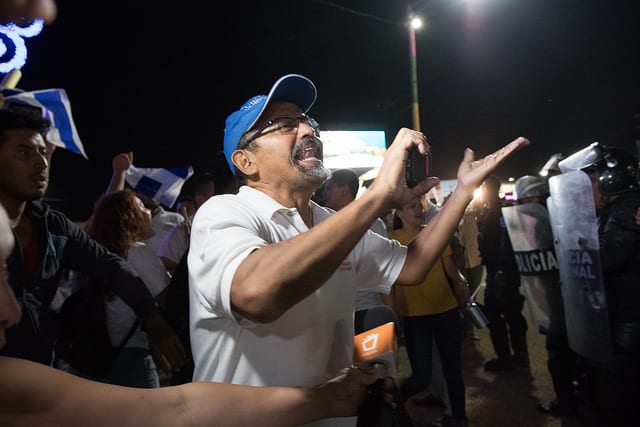Peaceful Protests against Nicaraguan Social Security Reforms Violently Repressed
Members of the Sandinista Youth armed with iron pipes pitch into the crowd with police protection.
Huge mobilization of riot police along the “Camino del Oriente” roadway. Journalists from a number of media outlets were attacked and cameras stolen.
Summary of articles in Confidencial

HAVANA TIMES – Violence broke out in Managua on Wednesday, April 18, when members of the Sandinista Youth deploying sticks, pipes and stones, along with the Riot Police forces, repressed a march of young people and adults.
The marchers, organized through social media, had gathered along the Camino del Oriente near a large commercial center in Managua to protest recent reforms to the Nicaraguan Social Security Institute (INSS). These unpopular changes, declared by the government of Daniel Ortega, include a 5% decrease in pensions for old age and disability, and an increase in the monthly quotas paid by employers and workers.
The protest began at 5 pm and was met almost immediately by an aggressive group from the Sandinista Youth (Juventud Sandinista or JS). Several of those who arrived first were set upon by members of the JS, including photojournalist Alfredo Zuniga whose camera was stolen. Although the National Police were present, they did not come to the aid of the two victims.
Those who gathered to protest were unarmed and carried signs criticizing the reforms to social security. These were held up for passing cars to see. The two groups – protesters on one side and members of the Sandinista Youth on another – then faced off at opposite ends of the street, with protesters shouting “No to the INSS reforms,” and the Ortega backers responding with cries of: “You’re thieves!” and “Sell-outs, sell-outs!”
Other citizens were forced to move off the highway, and after a short time the confrontation turned violent. Rene Cuadra, a cameraman from the TV channel “100% News” [“100% Noticias”] was ambushed by a group of some 20 JS members who took his camera.

By 6 pm, the protesters appeared to have the majority, and their demonstration seemed to be going forward towards the Centroamerica roundabout without further problems. However, at that moment some 200 members of the riot squad appeared and proceeded to block the path of the demonstrators, with use of protective shields, tear gas and nightsticks. Demonstrators and journalists attempting to break through the police barrier were pushed by the shields, and in some cases beaten.
Protesters attacked by Sandinista Youth and the riot squad
By 6:40 the group of demonstrators arrived at the Jean Paul Genie roundabout and entered the vacant area that exists in the middle. The riot squad then attempted to close off the perimeter, and with aid from members of the Sandinista Youth began pursuing both protesters and journalists. Stones were thrown, and protesters and reporters were pinned down, beaten and robbed by three or four aggressors at a time. At this point, the demonstrators began fleeing in all directions, including attempts to enter surrounding gas stations and other businesses for safety. Another reporter, this time from the radio station Onda Local was knocked down and beaten. He was taken to a nearby hospital in serious condition.
Gonzalo Carrion, legal director of Cenidh, the Nicaraguan Human Rights Center stated that the Police were serving as a repressive organ towards the citizens who only wanted to protest for reforms to Social Security they considered “unjust”.
By around 7 pm, the last demonstrators had fled and the violence had ended.
University students also protest

While the riot squads were scattering the last groups of citizens, the university students were also protesting the social security reforms in front of the Central American University (UCA). The same general scene played out, with the rapid arrival of the Sandinista Youth and police on motorcycles. The UCA, then opened their gates and the students were able to retreat to safety with only a few light wounds and mild damage to the university infrastructure. The patrols were maintained until past 8 pm just in case the students returned to protest.
Similar scenes played out in other parts of Managua and in other cities. A group holding a vigil in the area of the Monte Espana Hospital, where a building financed by INSS is being constructed, was dispersed with force, and in the city of Leon yet another group came out in protest and were repressed.
Reforms “to save Social Security” widely questioned
The controversial reforms to the Nicaraguan Institute of Social Security (INSS) were dictated by the Institute’s president, Roberto Lopez, and officialized via presidential decree on Tuesday, April 17, by President Daniel Ortega. They include a 5% decrease on old age and disability pensions, to finance the pensioners’ medical attention, and an increase in the quotas paid by workers and employers of 7% and 22% respectively.
With this increase, the government hopes to bring in an additional US $220 million, but there has been no effort to balance the agency budget or to make public the current financial situation, beyond stating that the Social Security agency has been in the red since 2013 and is on the point of bankruptcy.
Vice President Rosario Murillo minimized the changes in her daily discourse, stating: “We’re working to guarantee that right…to live with the certainty that at the hour of an illness, the hour of a calamity, we’re going to be protected..”
Her remarks have not appeased an indignant public, and at press time on Thursday, the demonstrations and the violent scenes of repression, continued, spreading to as many as eight cities.





